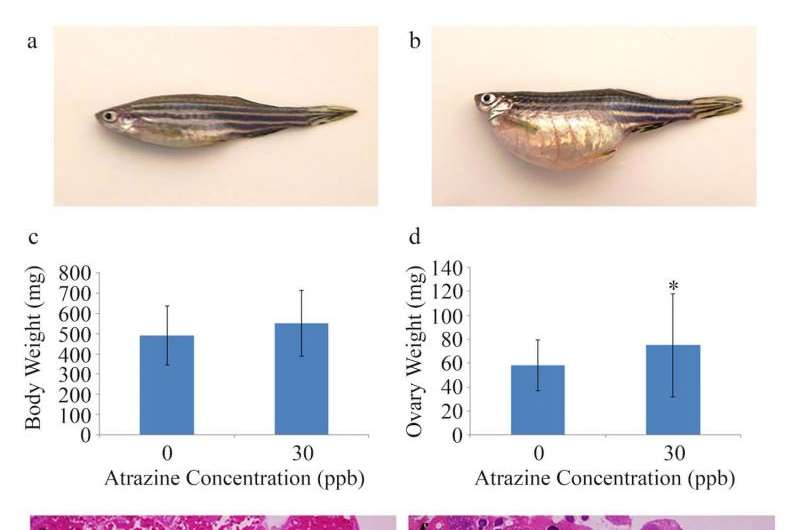Zebrafish embryos exposed to atrazine pass on health problems to their young

Atrazine exposure during embryonic development could cause later reproductive problems for female zebrafish, as well as physical deformations in their offspring, according to new research from Purdue University.
"This approach to show the later-in-life consequences is novel because this is the first study of the offspring of female fish that were exposed to atrazine during their first 72 hours of life," said Jennifer Freeman, an associate professor of toxicology in the School of Health Sciences. "Other studies expose the parents when they are adults and then study the offspring. But by exposing during embryogenesis, we will have a better idea of the total effects. For example, we found physical deformations in the offspring as well as complications with breeding and increases in progesterone for the parents."
These findings are reported in Nature's Scientific Reports, and the research was supported by the National Institutes of Health and the National Institute of Environmental Health Sciences.
Atrazine, an agricultural herbicide, is a suspected endocrine-disrupting chemical. It is used to kill broadleaf and grassy weeds in crops, such as corn, especially in the Midwest, and it often contaminates water supplies. The federally approved amount of atrazine in drinking water is 3 parts per billion, but workers can be exposed to larger levels, such as 30 parts per billion, and larger amounts may be present in surface water.

In this study, the fish were exposed during the 72-hour embryonic development time, which mirrors human prenatal development, to atrazine at levels of 0, 0.3, 3 or 30 parts per billion.
When the fish reached maturity, it was found that 5 percent of the females exposed to 30 parts per billion had swollen abdomens.
"The physical appearance was similar to what would happen if females became egg-bound because there were no males to mate with, but these fish were paired for breeding," Freeman said. "We also controlled for any other pathogens or infections. This is the hardest thing for us to explain right now; yes, we do see this phenotype in some of the fish, but why don't we see it in all of the females who were exposed to 30 ppb?"
These fish with the swollen abdomens also had an increase in atretic ovarian follicles. It has been shown that atrazine affects the LH gene, which produces the hormone that triggers ovulation and plays a key role in follicle development.
"Our findings and previous research suggest that a later-in-life effect of atrazine exposure could be due to the previously observed reduction in LH, providing a mechanism behind the observed reduction in spawning, atretic follicles and cystic ovarian degeneration," Freeman said.
In this study, when the fish reached maturity they were paired for breeding. Compared to the control group, females exposed to 30 parts per billion were not successful at breeding in general, whether their abdomens were swollen or not. For the fish that released eggs, their offspring hatched and survived.
"There were no gross malformations, but a closer look showed that there was a decrease in head length to body length ratio at the highest dose of 30 ppb," Freeman said. "At the middle doses of 0.3 and 3 ppb, we saw a significant increase in head width to total body length ratio."
Freeman's previous research also found these physical effects in offspring that were exposed directly during their first 72 hours of life.
In this study, there also was an increase in progesterone levels in groups 3 and 30. There was a slight increase in the 0.3 parts per billion group, but it was not significant.
Freeman's research will continue to look at related mechanisms, and she also is looking at the same lifecycle for male fish.
"There are great concerns here, especially as we try to identify the origins and mechanisms of the dysfunction," Freeman said. "This shows that exposure can have lasting effects for the next generation."
More information: Sara E. Wirbisky et al. An embryonic atrazine exposure results in reproductive dysfunction in adult zebrafish and morphological alterations in their offspring, Scientific Reports (2016). DOI: 10.1038/srep21337
Journal information: Scientific Reports
Provided by Purdue University



















